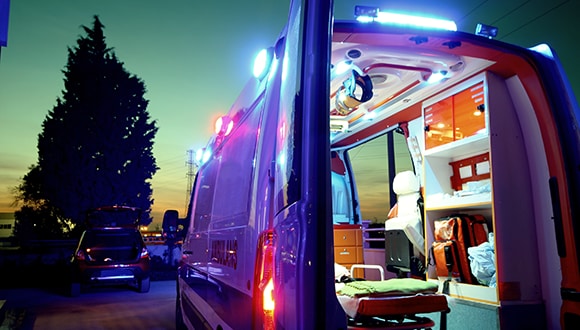Who pays for an ambulance in an emergency?
A growing number of Australians are being hit with unexpected costs for emergency ambulance call-outs. Here’s what you need to know.
If you fall seriously ill or are injured, it’s reassuring to know you can call an ambulance and medical help will be on its way. In an emergency, paramedics can save lives.
In NSW alone, an ambulance responds to a 000 call every 26 seconds. In 2018–19 ambulance services responded to 4.8 million incidents and assessed, treated or transported 3.7 million patients across Australia*.
But did you know that ambulance call out fees aren’t covered by Medicare? A survey by finder.com.au found 30% of Australians think they are. This can leave Aussies shocked when they get a bill and realise they may be out-of-pocket hundreds, or even thousands, of dollars.
Adding to the confusion is the fact there’s no national ambulance provider and the way ambulances are billed differs across our states and territories. In some parts of the country, the state government covers the cost of state-provided emergency ambulances, in others you’ll need private health insurance to avoid out-of-pocket costs.
There’s a further level of complexity if you need an ambulance outside of your home state, or the hospital you’re transported to is across a state line.

Here’s a high level explanation of how it works across Australia:
Residents of NSW & ACT
In NSW or ACT
Emergency ambulances aren’t fully covered by the state government unless you hold certain government concession cards. To avoid out-of-pocket costs, you can get get private health insurance that includes ambulance cover.
HCF hospital and extras insurance covers state provided emergency ambulance services to the nearest hospital able to treat you. On some levels of HCF cover, you may also be able to claim up to $5,000 per person, per year for non-emergency, medically necessary ambulance transport by state providers.
Interstate
If you have HCF hospital cover you’re entitled to fully covered state emergency ambulance transport across most of Australia under a levy arrangement. This excludes services in Qld and SA (and also WA for ACT residents) but you may be able to claim under your HCF cover.
If you have standalone HCF extras cover you may be covered for unlimited emergency ambulance for transport in NSW or ACT. On some levels of cover there’s an annual limit of 1 claim per person and 2 per policy for states other than NSW and ACT.
NSW and ACT residents can also buy standalone ambulance only cover for nationwide emergency ambulance coverage.
Residents of Queensland
State ambulance services are covered by your state government Australia-wide, so you don’t need separate insurance.
Residents of Tasmania
State road ambulance services are covered by your state government across Australia, except for Qld and SA. You may be able to claim for services not covered by your state scheme under your HCF cover (limits may apply if you have standalone extras cover).
Residents of Victoria, SA, WA & NT
You need either private health insurance that includes ambulance cover, like HCF’s ambulance only cover or a subscription with your local ambulance service.
When should I call an ambulance?
Ambulance NSW recommends you call 000 for medical emergencies including:
- serious accident or injury
- chest pain, chest tightness or breathing difficulties
- uncontrollable bleeding
- a sudden collapse or unexplained fall
- serious burns, particularly in young children
- infants who are fitting or have an ongoing fever
- if a person is unconscious or having difficulty breathing.
What about non-emergency ambulance use?
Some HCF products cover you if you call an ambulance for a non-emergency, but limits may apply. We recommend you check your policy summary to see if your covered. You can also read more about what’s considered an emergency, and what’s included under emergency and non-emergency ambulance cover, in the HCF Member Guide or Fund Rules.
What should I consider when I get ambulance cover?
“As ambulance cover can be complicated, we recommend you talk to your health fund,” says HCF’s Ann O’Gorman Skarratts. “Like any type of insurance, it’s important to ask questions about your policy and make sure you understand what you’re actually covered for.”
The Commonwealth Ombudsman recommends you ask whether your cover will include:
- interstate travel
- emergency situations only or non-emergency as well
- different types of ambulance transport, for example air ambulance, state-approved private providers or other private providers
- ambulance treatment where transportation to a hospital isn’t required
- the full fee, or whether you’ll have out-of-pocket costs.
Updated September 2021
Related articles
FIRST AID BASICS WE SHOULD ALL KNOW
Accidents happen. Do you know how to help someone who’s injured?
MY STORY: EXPERIENCING A HEART ATTACK
Healthy 56-year-old heart researcher Scott Kesteven had a heart attack. These are the warning signs he wished he’d paid attention to.
HOW TO PREVENT A STROKE
Learn how to protect yourself and recognise the signs of stroke in others.
Important Information
*Source Australian Government Productivity Commission
This communication contains information which is copyright to The Hospitals Contribution Fund of Australia Limited (HCF). It should not be copied, disclosed or distributed without the authority of HCF. Except as required by law, HCF does not represent, warrant and/or guarantee that this communication is free from errors, virus, interception or interference. All reasonable efforts have been taken to ensure the accuracy of material contained on this website. It’s not intended that this website be comprehensive or render advice. HCF members should rely on authoritative advice they seek from qualified practitioners in the health and medical fields as the information provided on this website is general information only and may not be suitable to individual circumstances or health needs. Please check with your health professional before making any dietary, medical or other health decisions as a result of reading this website.